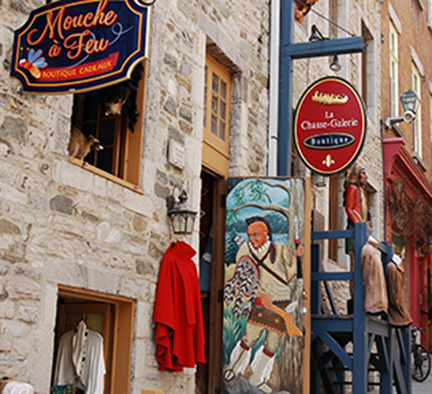
This Quebec City street shows influence of the early fur trade.
Paschal worked as a fur trader and translator
The first of the Pensoneau brothers to settle in Cahokia was Louison, who arrived in U.S. territory in 1784. He was a fur trader among the Kickapoo, Potawatomie and Miami Indians in Indiana and Illinois. In a memoir dictated in 1883, his son Paschal said, “My father was head-boss for the American Fur Company,” owned by Jacob Astor, on the Wabash and Vermillion rivers. For a time, Louison kept a second home in Peoria, Illinois.
Louison married Louise “Lizette” LeCompte, daughter of “Old Mme. LeCompte,” who lived to 109 years of age. She was half Potawatomie, spoke several Indian languages, and was legendary as a peacemaker. When she heard of impending attacks against the town of Cahokia in its early days, she would walk into the woods on her own to parley. Several days later, she would return with a party of Indians who had decided not to attack but to accept the gifts and hospitality the townspeople were only too happy to offer to avoid a battle. Often, the feasting continued for days. Louison and Lizette had ten children, and one followed in both his father’s and grandmother’s footsteps. Paschal, born in 1795, lived largely among the Kickapoo Indians from the time he was thirteen years old.
“I went to Terre Haute, where there was a trading post. My father gave me a set of tools so that I could repair the Indian guns, and I followed that business a great deal,” he said in his memoir recorded by the Kansas State Historical Society.
French fur-trading families often exchanged young men with Indian families, so the boys would grow up familiar with each other’s society, culture and language. The French youth who lived among the Indians were called coureurs des bois, or runners of the woods.
By the 1830s, Paschal worked for Stephen Phelps, one of two main traders with Black Hawk’s band of Sac and Fox Indians. When the Illinois militia and then the U.S. Army were called up to oust Black Hawk and his followers from Illinois in the summer 1832, Paschal enlisted in the militia. Black Hawk was defeated in the brief war, and his bands were forced to leave their traditional seasonal homes for the plains west of the Mississippi River. Phelps accompanied Black Hawk to Washington, D.C., for the treaty negotiations.
The U.S. Congress passed the Indian Removal Acts at about the same time. These events forced Indians to move west of the Mississippi River, and the Kickapoo—who had allied with the Americans—also had to leave their land in Illinois.
Paschal stayed with the Kickapoo and traveled west. He married Shikina, the daughter of a chief, and went with a group of sixty-three families to live along the Missouri River above Fort Leavenworth. They stayed there for about five years before moving to Kansas, where Paschal is credited with being the first white settler of Atchison. The couple had a number of children, and they eventually settled on the Kickapoo reservation. Paschal gave the account of his life in 1883 as part of establishing land claims for his military service and for his wife’s and children’s rights to tribal lands.
Paschal continued to work as a trader and interpreter in Kansas, and he was the interpreter for the Kickapoo Treaty signed June 28, 1862. He also served as an interpreter for the U.S. Army during the Civil War.
Paschal returned once to Illinois, in the late 1870s, when he was about 80 years old, but by then his parents, brothers and sisters had all died. An account by John F. Snyder, a family friend, stated that Paschal’s marriage had never been accepted by his siblings, “who ranked socially among the highest class of citizens here ... and if they did not disown him outright, they called ‘off’ and never mentioned his name and really did not know where he was or care to know.”
Paschal visited with Snyder’s brother, who “described him to me as a striking figure, of stately patriarchal appearance, and an intelligent, dignified and courteous gentleman. He was well dressed, and perfectly at his ease, with nothing in speech or manners to indicate his long association with Indians ... I feel quite sure that the Indian woman Paschal married was fully his peer in all that pertains to moral, social and domestic life.”
Pascahl and Shikina’s descendants have been active in Indian affairs and leadership positions over generations, and family members maintain websites with historical documents and photos. Especially helpful are the sites that Velma Louise Pensoneau Jones and Donna Flood maintain at www.electricscotland.com
